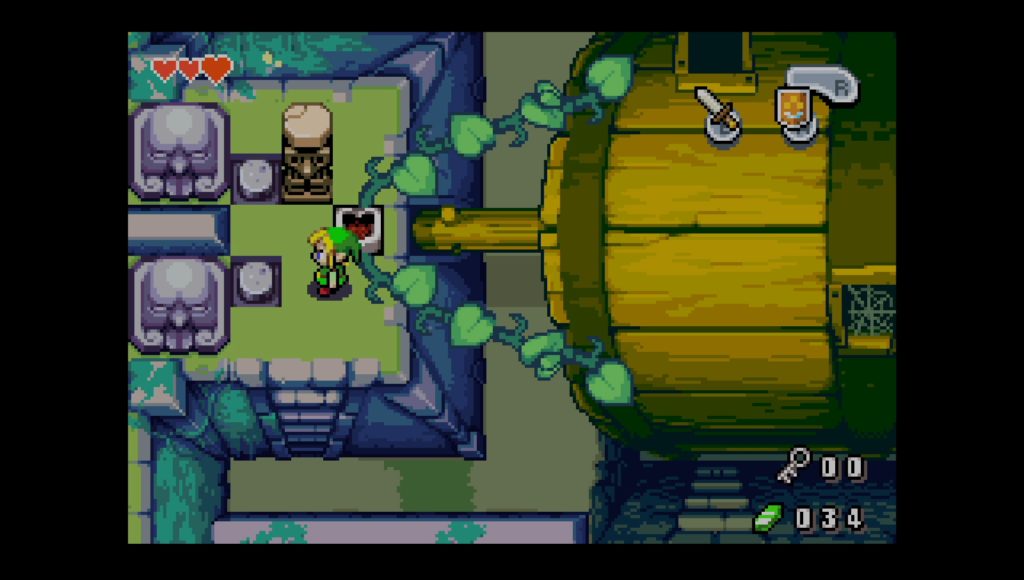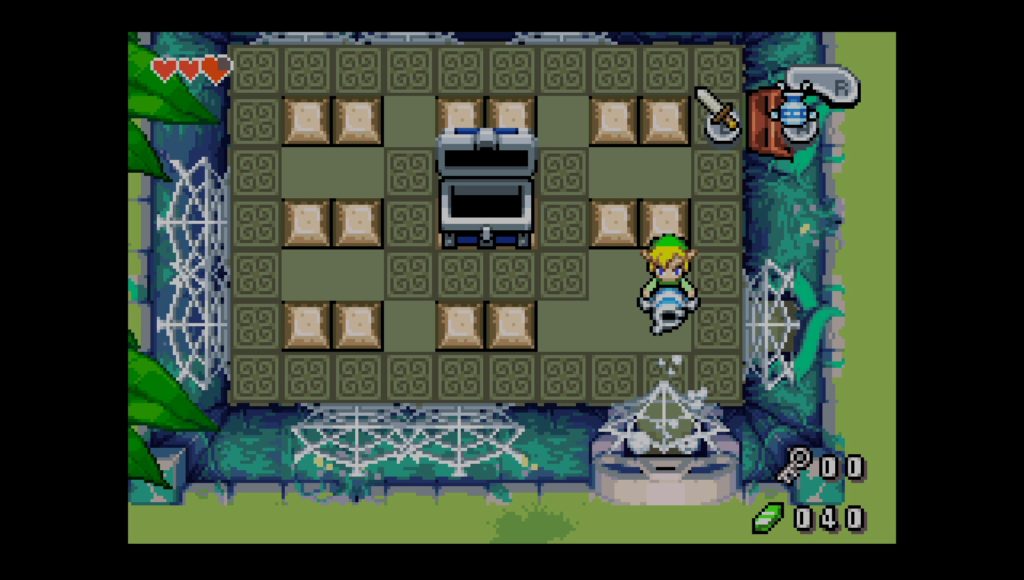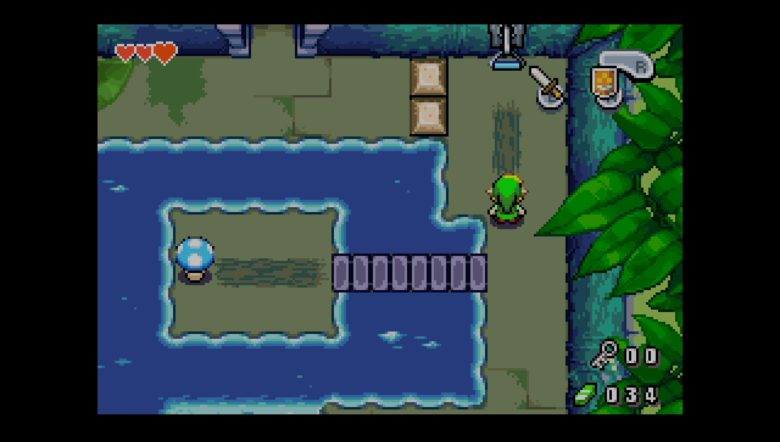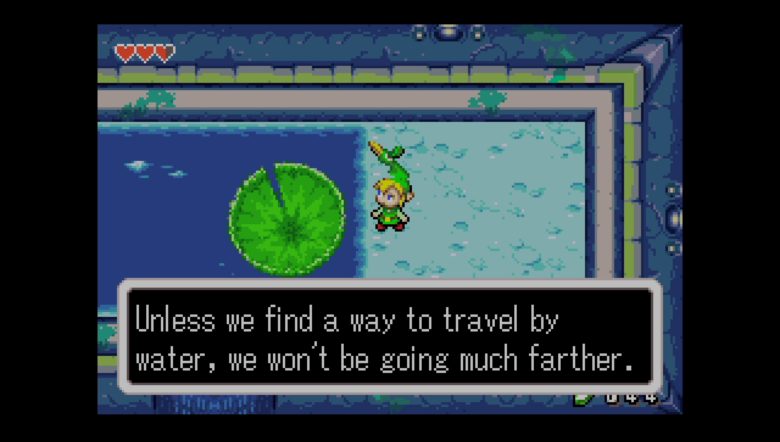For this, the second post in a series on the introductory stages in video games, we’ll be focusing on The Legend of Zelda: The Minish Cap. Off the bat, it should be acknowledged that this post doesn’t technically start right at the beginning of the game, but at the first dungeon, which is about ten to fifteen minutes after the player takes control.
The Deepwood Shrine is, as the name implies, found deep within the woods in the southeastern corner of Hyrule. While in the dungeon, the player is under the effects of one of the game’s primary mechanics, a shrinking transformation as a result of the titular Minish Cap. As such, several of the area’s puzzles take the form of ordinary objects which appear larger than they ordinarily would be.

One example presents itself in the first room: spiderwebs blatantly placed over a pair of doorways at the entrance. The player can’t do anything about them at first–they just bounce off if they touch them–but they introduce a key component of the rest of the game. As the player can freely explore the extent of the dungeon available, there have to be elements which attract the player’s attention and give them a reason to come back.
Not three rooms later, the dungeon’s other major mechanic is introduced in the form of unusually elastic mushrooms. Before the player can reach the mushroom, they must pull a lever to make a bridge across to it. This requires them to learn how pulling objects works, then apply it in another way to slingshot over water using the mushroom. The dungeon continues to build on the basic mechanic of pulling with more complex mushroom puzzles throughout, as well as several statue-based puzzles later on.
The dungeon opens up into a large hub room of sorts at this point, and before the player can proceed, there’s another bit of subtle learning required. The centerpiece of the hub room is a barrel, attached on an axle to each side of the room. However, the sides are overgrown with vines at first, and the player has to activate torches to burn them off.

On the right side, a single square pressure plate–which mirrors the plates in earlier rooms which stay pressed after being stepped on–does the job. On the left, however, there are two circular plates, which only remain active as long as something remains on them.

Immediately next to one of them is a statue which the player must push onto it to activate the second torch. This provides a clear example of how each type of plate functions, so such effects can be assumed later in the game.
Less than five rooms into the dungeon, its main points have already been established. The majority of the puzzles revolve around pushing, pulling, and using both varieties of pressure plates, sometimes in concert.

These simple mechanics lay groundwork that later dungeons can implicitly build from, so the concepts don’t have to be reestablished every time they appear. However, there are still the dungeon-specific obstacles: the aforementioned spiderwebs along with piles of dust scattered about the floor.
Enter a Legend of Zelda series staple, the dungeon item. The Deepwood Shrine plays host to an odd little item called the Gust Jar which essentially acts as a magical vacuum cleaner, capable of drawing in nearby objects and expelling them at high velocity. In the room where the item is obtained, the entrance closes and remains shut even after defeating the miniboss, but nearly every free inch of wall space is covered with the same sorts of spiderwebs as seen in the first room. This also extends to another pair of doors, one of which leads out of the room, while the other leads to a dead end with a Heart Piece–one fourth of a Heart Container which expands the player’s maximum life capacity. It also comes fairly easily to mind that a magic vacuum would take care of dust, and an observant player can return to earlier rooms to uncover pressure plates hidden by dust, which in turn cause treasure chests to appear as reward.

The rest of the dungeon blends the previously-established elements with the newfound capabilities of the Gust Jar–for instance, the mushrooms can be grabbed from afar using the item’s suction–to continue to challenge the player’s competency with the concepts.

The boss, too, bears the series-staple weakness to the item it guards, but is notable for the fact that it is simply a normal enemy that seems monumental to the player’s diminutive size. A lack of options combined with a tendency to keep the dungeon item equipped quickly makes the solution evident, and the guardian slime monster falls.
As a final note, I should address something I’ve been glossing over about the presentation of the dungeon: Ezlo, the titular Minish Cap. Ezlo acts as the game’s companion character, and has a tendency to interrupt gameplay to comment on the surroundings, usually in the form of thinly-veiled pushes in the direction of progress. This isn’t inherently a bad thing, and it fits the narrative of the game–early on, Ezlo has little faith in or knowledge of the protagonist’s abilities, and interrupts to give his advice because of it. Later, he knows the protagonist quite well, and has a greater understanding of what he’s capable of, thus needing less guidance. However, his tutorial messages throughout the dungeon tend to overshadow the subtlety of the level design in guiding the player by its own merits, giving it less of an opportunity to shine.











This was my introduction to the Zelda series. You make a good case for this being a good place to start!